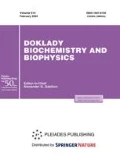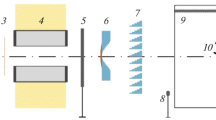Abstract
The effect of proton pencil beam scanning in the dose range of 4.5–15 Gy on the radiosensitivity of mice under irradiation in two regions of the Bragg curve was studied according to the criteria of 30-day survival, dynamics of death, and average lifespan of mice. The relative biological effectiveness (RBE) value of protons relative to X-ray radiation before and at the Bragg peak determined by the LD50/30 index was 0.86 and 0.94, respectively, and by the criterion of 30-day survival at a dose of 6.5 Gy it was 0.83 and 0.84, respectively. With similar RBE values for protons in different regions of the Bragg curve, significant differences in the dynamics of the course of radiation sickness were revealed, which indicates different damage to critical systems and organs of animals and the induction of compensatory mechanisms involved in the formation of stress responses at the organismal level.


Similar content being viewed by others
REFERENCES
Ilicic, K., Combs, S.E., and Schmid, T.E., New insights in the relative radiobiological effectiveness of proton irradiation, Radiat. Oncol. Lond. Engl., 2018, vol. 13, no. 6.
Thomas, H. and Timmermann, B., Paediatric proton therapy, Br. J. Radiol., 2020, vol. 93, no. 1107.
Hu, W., Hu, J., Gao, J., et al., Outcomes of orbital malignancies treated with eye-sparing surgery and adjuvant particle radiotherapy: a retrospective study, BMC Cancer, 2019, vol. 19, no. 776.
Onyeuku, N. Diwanji, T., et al., Advances in proton therapy in lung cancer, Ther. Adv. Respir. Dis., 2018, vol. 12.
Kamran, S.C., Light, J.O., and Efstathiou, J.A., Proton versus photon-based radiation therapy for prostate cancer: emerging evidence and considerations in the era of value-based cancer care, Prostate Cancer Prostatic Dis., 2019, vol. 22, no. 4, pp. 509–521.
Paganetti, H., Blakely, E., Carabe-Fernandez, A., et al., Report of the AAPM TG-256 on the relative biological effectiveness of proton beams in radiation therapy, Med. Phys., 2019, vol. 46, no. 3.
Mohan, R., Peeler, C.R., Guan, F., et al., Radiobiological issues in proton therapy, Acta Oncol., 2017, vol. 56, no. 11, pp. 1367–1373.
Chaudhary, P., Marshall, T.I., Perozziello, F.M., et al., Relative biological effectiveness variation along monoenergetic and modulated Bragg peaks of a 62-MeV therapeutic proton beam: a preclinical assessment, Int. J. Radiat. Oncol. Biol. Phys., 2014, vol. 90, no. 1, pp. 27–35.
Bao, C., Sun, Y., Dong, Y., et al., The relative biological effectiveness of proton and carbon ion beams in photon-sensitive and resistant nasopharyngeal cancer cells, Transl. Cancer Res., 2018, vol. 7, no. 1, pp. 170–179.
Smith, J., Broek, F., Martorell, J., et al., Principles and practice in ethical review of animal experiments across Europe: summary of the report of the FELASA working group on ethical evaluation of animal experiments, Lab. Anim., 2007, vol. 41, no. 2, pp. 143–160.
Yarmolenko, S.P. and Vainson, A.A., Radiobiologiya cheloveka i zhivotnykh (Radiobiology of Humans and Animals), Moscow: Vysshaya Shkola, 2004.
Ul'yanenko, S.E., Koryakin, S.N., Isaeva, E.V., et al., Assessment of the biological efficiency of neutron radiation of the BARS-6 reactor with different dose rates by the criterion of the survival of mice, Radiats. Biol. Radioekol., 2016, vol. 56, no. 6, pp. 598–605.
Tatsuzaki, H., Inada, T., and Shimizu, T., et al., Early skin reaction following 250 MeV proton peak irradiation, J. Radiat. Res., 1987, vol. 28, no. 2, pp. 150–155.
Sorensen, B.S., Bassler, N., Nielsen, S., et al., Relative biological effectiveness (RBE) and distal edge effects of proton radiation on early damage in vivo, Acta Oncol., 2017, vol. 56, no. 11, pp. 1387–1391.
Balakin, V.E., Rozanova, O.M., Smirnova, E.N., et al., The effect of low and medium doses of proton pencil scanning beam on the blood-forming organs during total irradiation of mice, Dokl. Biochem. Biophys., 2020, vol. 494, no. 1, pp. 231–234.
Koryakina, E., Troshina, M., Potetnya, V., et al., Biological efficiency of a scanning proton beam under different irradiation modes in vitro, in Book of Abstracts, Eighth International Conference on Radiation in Various Fields of Research; Virtual Conference, 2020, p. 125.
Spadinger, I. and Palcic, B., The relative biological effectiveness of 60Co gamma-rays, 55 kVp X-rays, 250 kVp X-rays, and 11 MeV electrons at low doses, Int. J. Radiat. Biol., 1992, vol. 61, no. 3, pp. 345–353.
Problemy kosmicheskoi biologii (Problems of Space Biology), vol. 60: Biofizicheskie osnovy deistviya kosmicheskoi radiatsii i izluchenii uskoritelei (Biophysical Foundations of the Action of Space Radiation and Radiation of Accelerators), Zhukovskaya, N.E. and Chernozhukova, E.M., Eds., Leningrad: Nauka, 1989.
Beketov, E.E., Isaeva, E.V., Nasedkina, N.V., et al., Uniformity of the biological dose in the distributed Bragg peak of a therapeutic device with a scanning proton beam, Vopr. Onkol., 2019, vol. 65, no. 4, pp. 532–536.
Funding
The work on determining the value of the relative biological efficiency of a proton pencil beam scanning in mice in vivo was carried out on the basis of the Physical Technical Center of the Lebedev Physical Institute and the Institute of Theoretical and Experimental Biophysics, Russian Academy of Sciences in the framework of basic research on topics of stage assignment with partial financial support of the R&D agreement between Physical Technical Center of the Lebedev Physical Institute and the Institute of Theoretical and Experimental Biophysics, Russian Academy of Sciences no. 06/20.
Author information
Authors and Affiliations
Corresponding author
Ethics declarations
Conflict of interest. The authors declare that they have no conflict of interest.
Statement on the welfare of animals. All applicable international, national and institutional guidelines for the care and use of animals have been observed in the performance of the work. The studies were carried out in accordance with the requirements of the Federation of European Laboratory Animal Science Association (FELASA) on the maintenance and use of laboratory animals in scientific research, and the experimental plan was approved by the Commission on Biological Safety and Bioethics of the Institute of Theoretical and Experimental Biophysics, Russian Academy of Sciences (protocol no. 8/2020 dated February 17, 2020).
Additional information
Translated by M. Batrukova
Rights and permissions
About this article
Cite this article
Balakin, V.E., Rozanova, O.M., Smirnova, E.N. et al. Assessment of the Relative Biological Efficiency of Pencil Beam Scanning of Protons in Mice in Vivo. Dokl Biochem Biophys 499, 215–219 (2021). https://doi.org/10.1134/S1607672921040037
Received:
Revised:
Accepted:
Published:
Issue Date:
DOI: https://doi.org/10.1134/S1607672921040037




